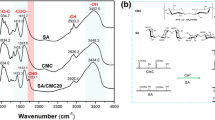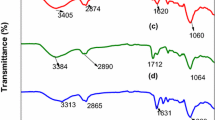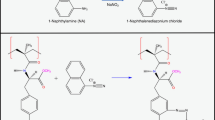Abstract
A composite biosorbent retaining non-covalently bound chitin in between layers of a silicon oxide matrix was assessed for lysozyme purification from undiluted egg white. The matrix can be shaped with big size and high density, thus allowing its efficient separation from the egg white after the adsorption step. The lysozyme-depleted egg white can follow its usual commercialisation route. A surface area of 142 m2/g and a total pore volume of 0.295 cm3/g were calculated from the nitrogen sorption isotherms. Its water content was 78.3%. The matrix structure is the result of the polysaccharide addition to the polymerisation mixture, which is known to influence the condensation process, leading to a material with characteristic properties. A maximum capacity of 117.1 ± 9 mg lysozyme/g and a dissociation constant of 0.73 ± 0.15 mg/mL were calculated from the Langmuir isotherm. A lysozyme purification batch process from undiluted egg white was developed, where 87% of the lysozyme was removed from the egg white and the matrix was easily recovered by a simple filtration through a strainer. The overall yield of the process was 64% with a purification factor of 20.





Similar content being viewed by others
References
Lienqueo ME, Asenjo JA (2000) Use of expert systems for the synthesis of downstream protein process. Comput Chem Eng 24:2339–2350
Safarik I, Safarikova M (1993) Batch isolation of hen egg white lysozyme with magnetic chitin. J Biochem Biophys Meth 27:327–330
Kurita K (2001) Controlled functionalization of the polysaccharide chitin. Progr Polym Sci 26:1921–1971
Pillai CKS, Paul W, ChP Sharma (2009) Chitin and chitosan polymers: chemistry, solubility and fiber formation. Prog Polym Sci 34:641–678
Guo TY, Xia YQ, Hao GJ, Zhang BH, Fu GQ, Yuan Z, He BL, Kennedy JF (2005) Chemically modified chitosan beads as matrices for adsorptive separation of proteins by molecularly imprinted polymer. Carbohydr Polym 62:214–221
Zeng X, Ruckenstein E (1998) Cross-linked macroporous chitosan anion-exchange membranes for protein separations. J Membr Sci 148:195–205
El-Tahlawy KF, El-Rafie SM, Aly AS (2006) Preparation and application of chitosan/poly (methacrylic acid) graft copolymer. Carbohydr Polym 66:176–183
Osifo PO, Webster A, van der Merwe H, Neomagus HWJP, van der Gun MA, Grant DM (2008) The influence of the degree of cross-linking on the adsorption properties of chitosan beads. Bioresour Technol 99:7377–7382
Brinker C, Scherer G (1990) Sol-Gel science, 1st edn. Academic Press, San Diego
Bond R, McAuliffe J (2003) Silicon biotechnology: new opportunities for carbohydrate science. Aust J Chem 56:7–11
Li F, Li J, Zhang S (2008) Molecularly imprinted polymer grafted on polysaccharide microsphere surface by the sol-gel process for protein recognition. Talanta 74:1247–1255
Shchipunov YA, Karpenko TY, Krekoten AV, Postnova IV (2005) Gelling of otherwise nongelable polysaccharides. J Colloid Interface Sci 287:373–378
Shchipunov YA, Kojima A, Imae T (2005) Polysaccharides as a template for silicate generated by sol-gel processes. J Colloid Interface Sci 285:574–580
Copello GJ, Varela F, Vivot RM, Diaz LE (2008) Immobilized chitosan as biosorbent for the removal of Cd(II), Cr(III) and Cr(VI) from aqueous solutions. Bioresource Technol 99:6538–6544
de la Rosa G, Gardea-Torresdey JL, Peralta-Videa JR, Herrera I, Contreras C (2003) Use of silica-immobilized humin for heavy metal removal from aqueous solution under flow conditions. Bioresource Technol 90:11–17
Cestari AR, Vieira EF, Pinto AA, Lopes EC (2005) Multistep adsorption of anionic dyes on silica/chitosan hybrid. 1. Comparative kinetic data from liquid- and solid-phase models. J Colloid Interface Sci 292:363–372
Li F, Du P, Chen W, Zhang S (2007) Preparation of silica-supported porous sorbent for heavy metal ions removal in wastewater treatment by organic-inorganic hybridization combined with sucrose and polyethylene glycol imprinting. Anal Chim Acta 585:211–218
Ehrlich H, Janussen D, Simon P, Bazhenov VV, Shapkin NP, Erler C, Mertig M, Born R, Heinemann S, Hanke T, Worch H, Vournakis JN (2008) Nanostructural organization of naturally occurring composites—Part II: silica-chitin-based biocomposites. J Nanomaterials. doi: 10.1155/2008/670235
Chan EL, Nakai S, Sim J, Bragg DB, Lo KV (1986) Lysozyme separation from egg white by cation exchange column chromatography. J Food Sci 51:1032–1039
Chen X, Liu JH, Feng ZC, Shao ZZ (2005) Macroporous chitosan/carboxymethyl cellulose blend membranes and their application for lysozyme adsorption. J Appl Polym Sci 96:1267–1274
Camperi SA, Navarro del Cañizo AA, Wolman FJ, Smolko EE, Cascone O, Grasselli M (1999) Protein adsorption onto tentacle cation-exchange hollow fiber membranes. Biotechnol Prog 15:500–505
Ventura AM, Fernández Lahore HM, Smolko EE, Grasselli M (2008) High-speed protein purification by adsorptive cation-exchange hollow-fiber cartridges. J Membr Sci 321:350–355
Junowicz E, Charm SE (1975) Purification of lysozyme by affinity chromatography. Febbs Lett 57:219–221
Yamasaki N, Eto T (1981) A novel adsorbent for affinity chromatography of lysozyme. Agric Biol Chem 45:2939–2941
Ruckenstein E, Zeng X (1997) Macroporous chitin affinity membranes for lysozyme separation. Biotechnol Bioeng 56:610–617
Grasselli M, Camperi SA, Navarro del Cañizo AA, Cascone O (1999) Direct lysozyme separation from egg white by dye membrane affinity chromatography. J Sci Food Agric 79:333–339
Yilmaz M, Bayramoglu G, Arica MY (2005) Separation and purification of lysozyme by reactive green 19 immobilised membrane affinity chromatography. Food Chem 89:11–18
Arica MY, Yilmaz M, Yalcin E, Bayramoglu G (2004) Affinity membrane chromatography: relationship of dye-ligand type to surface polarity and their affect on lysozyme separation and purification. J Chrom B 805:315–323
Tamura H, Nagahama H, Tokura S (2006) Preparation of chitin hydrogel under mild conditions. Cellulose 13:357–364
Bradford M (1976) A rapid and sensitive method for the quantitation of microgram quantities of protein utilizing the principle of protein-dye binding. Anal Biochem 72:248–254
Gorin G, Wang SF, Papapavlou L (1971) Assay of lysozyme by its lytic action on M. lysodeikticus cells. Analyt Biochem 39:113–127
Nakagawa T, Soga M (1999) A new method for fabricating water repellent silica films having high heat-resistance using the sol-gel method. J Non-Cryst Solids 260:167–174
Orel B, Jese R, Stangar UL, Grdadolnik J, Puchberger M (2005) Infrared attenuated total reflection spectroscopy studies of aprotic condensation of (EtO)3Si-R-Si(OEt)3 and R-Si(OEt)3 systems with carboxylic acids. J Non-Cryst Solids 351:530–549
Alvarez GS, Desimone MF, Díaz LE (2007) Immobilization of bacteria in silica matrices using citric acid in the sol-gel process. Appl Microb Biotechnol 73:1059–1064
Desimone MF, Matiacevich SB, Buera MdP, Díaz LE (2008) Effects of relative humidity on enzyme activity immobilized in sol-gel-derived silica nanocomposites. Enzyme Microb Technol 42:583–588
Sing KSW, Everett DH, Haul RAW, Moscow L, Pierotti RA, Rouquérol J, Siemieniewska T (1985) Reporting physisorption data for gas/solid system. Pure Appl Chem 57:603–619
Bayramoglu G, Ekici G, Besirli N, Arica Y (2007) Preparation of ion-exchange beads based on poly(methacrylic acid) brush grafted chitosan beads: isolation of lysosyme from egg white in bath system. Colloids Surf A Physicochem Eng Aspects 310:68–77
Ho YS, McKay G (2000) The kinetics of sorption of divalent metal ions onto sphagnum moss peat. Water Res 34:735–742
Chang YK, Chang IP (2006) Method development for direct recovery of lysozyme from highly crude chicken egg white by stirred fluidized bed technique. Biochem Bioeng J 30:63–75
Ghosh R, Cui ZF (2000) Purification of lysozyme using ultrafiltration. Biotechnol Bioeng 68(2):191–203
Acknowledgments
This work was supported by grants from the Agencia Nacional de Promoción Científica y Tecnológica de la República Argentina, the Universidad de Buenos Aires and the Consejo Nacional de Investigaciones Científicas y Técnicas (CONICET). FJW, OC, GJC, MVM and LED are researchers of the CONICET.
Author information
Authors and Affiliations
Corresponding author
Rights and permissions
About this article
Cite this article
Wolman, F.J., Copello, G.J., Mebert, A.M. et al. Egg white lysozyme purification with a chitin–silica-based affinity chromatographic matrix. Eur Food Res Technol 231, 181–188 (2010). https://doi.org/10.1007/s00217-010-1263-1
Received:
Revised:
Accepted:
Published:
Issue Date:
DOI: https://doi.org/10.1007/s00217-010-1263-1




